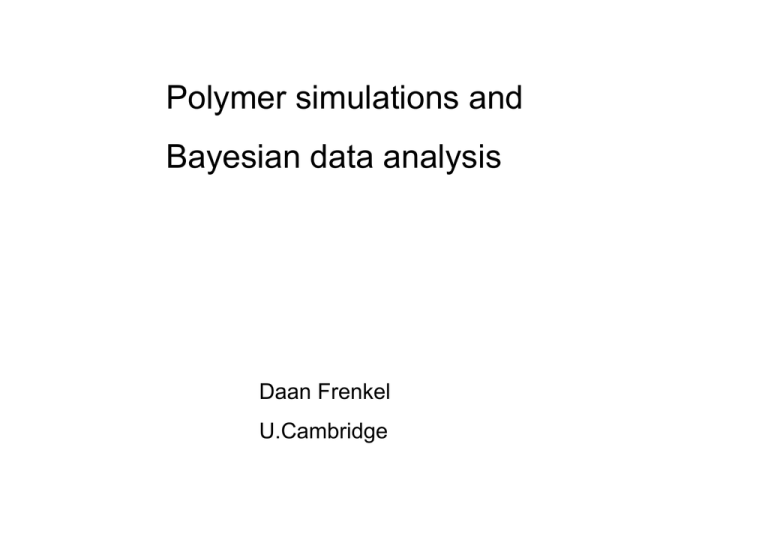Polymer simulations and Bayesian data analysis Daan Frenkel U.Cambridge
advertisement

Polymer simulations and Bayesian data analysis Daan Frenkel U.Cambridge With: Behnaz Bozorgui Columbia U/AMOLF Kostya Shundyak AMOLF Outline: 1. Recursive enumeration a) Dynamics (simulation) b) Polymer statistics (simulation) 2. Molecular Motors (experiments!) (well, actually, simulated experiments) Background: Velocity auto-correlations functions exhibit algebraic long-time tails. Always. On-lattice, off-lattice. Ballistic (MD), Diffusive (Lorentz-gas) Background: Recursive algorithms allow very accurate computation of <v(0).v(t)> for lattice models. Example: 2D Lorentz gas Vx(0)=1 Vx(0)=1 <Vx(1)>=0 X Vx(0)=1 X Vx(0)=1 <Vx(1)>=-1/4 0 0 -1/4 0 -1/4 X 1/4 0 -1/4 X X -1/4 1/4 X X -1/4 X 0 X 0 1/4 X 1/4 1/4 X X <Vx(1)>i 0 0 -1/16 0 1/16 X 0 X 0 X X 0 X X X 0 X 0 X X <Vx(2)>i 0 Iterate recursively: <Vx(3)>i , <Vx(4)>i , <Vx(5)>i , … , <Vx(n)>i , Method can be generalised to lattice-gas cellular automata (“hydrodynamic long-time tails”) Application to (lattice) polymers: This method is exact for non-self-avoiding, noninteracting lattice polymers. It can be used to speed up MC sampling of (self)interacting polymers B. Bozorgui and DF, Phys. Rev. E 75, 036708 (2007)) END OF INTRODUCTION Molecular Motors… Kinesin motor steps along micro-tubules with a step size of 8nm Experimentally, the step size is measured by fitting the (noisy) data. Example: noisy “synthetic data” Example: noisy “synthetic data” : “true” trace Best practice: “fit steps to data” J.W.J. Kerssemakers et al. , Nature 442,709 (2006) A recent article [Carter et al, Biophys. J. 94, 306(2008)] compared all existing step fitting methods and concluded: i.e. Kerssemakers et al. How well does it perform? 1. It can be used if the noise is less than 60% of the step size. 2. It yields a distribution of step sizes (even if the underlying process has only one step size) Observation: We want to know the step size and the step frequency but… We do not care which trace is the “correct” trace. Bayesian approach: compute the partition function Q of nonreversing polymer in a rough potential energy landscape “true” trace Other directed walks As shown before: we can enumerate Q exactly (and cheaply). From Q we can compute a “free energy” Compute the “excess free energy” with respect to reference data More detailed analysis (including noise estimates etc): Determine the maximum “modulation amplitude” The present method works well, up to twice the noise levels where the best existing methods fail. 0.2 0.25 0.5 1 Now, the analysis of the original “noisy data” Step size/noise =1 The blue crosses show the final result. Would we be able to detect if a stepping process contains 2 step sizes instead of 1? Example: analyse trace with sequence of step sizes: 5-11-5-11-5-11- nm (average: 8nm, as before) Trial step size 1. Back-stepping and multiple step sizes can be accounted for 2. Non-Poissonian statistics too (…or so I think) 3. Approach is not limited to analysing stepping motors (…this seems a safe bet)


